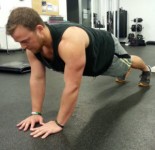10 Press Up Progressions
A press up to the Brits or a push up across the pond, is a common strength training exercise that dates back to the earliest forms of physical conditioning, embraced by the military throughout the 20th century and today a common sight in any gym around the world. Each of the press ups discussed in this article is designed to draw the focus of the movement onto a particular muscle group and increasingly intensify the exercise. A press up is not simply an exercise for developing bigger and stronger arm and chest muscles. Done with the proper technique a press up can help tone and strengthen the deltoids, the entire abdomen and even the muscles of the lower body.
The Common Press Up
Common Press Up – The basic template for any press up begins in front support, with your arms straight and your hands placed slightly wide of shoulder width apart, your shoulders directly above your hands and a straight line running from your shoulders through your hips to your feet. The body remains in a straight position as it is lowered towards the floor, keeping the necessary body weight above the hands. The arms bend to a 90 degree angle, stopping with the chin touching the floor. At no point should the chest or stomach touch the floor.
Press Ups for Beginners
For those not yet able to do the common press up, there are several options for beginners:
- Kneeling Press Up – By placing the knees on the floor you are reducing the amount of weight centred over the hands and are reducing the stress put on the abs. It is important when performing the movement that the individual keeps a straight line from the shoulders through the hips to the knees.
- Wall Press Up – These begin with the individual placing their hands against a wall or another flat surface and performing the exercise upright, this again reduces the amount of body weight being pressed during the movement, to increase the difficulty the individual needs to gradually move their feet away from the wall.
- Slow Press Up – In order to develop the muscle necessary to perform a movement it is often helpful to perform the opposite movement slowly. Hold yourself in the front support position and slowly for the count of ten lower yourself in a reverse press up. This exercise will condition the same muscles needed to perform a common press up.
How to Progress Your Press Up
As you become more advanced, you can try different press up options, including the following:
- Narrow / Marine Press Up – These are performed with the hands placed just inside of shoulder width. Instead of allowing the arms to bend to the side throughout the movement the arms are drawn backwards against the body. This variation focuses on the arm muscles especially the triceps.
- Wide Press Up – Begin your press up by increasing the distance in which your hands are apart. Increasing this distance will force the Lats to work harder and tone the muscles across the back.
- Diamond Press Up – Diamond push-ups are more difficult than the standard push-up as they force your weight on to a smaller surface area increasing the effort needed to perform the exercise. Placing your hand in a diamond shape with your fingers and thumb touching, perform the press up by lowering the body until the centre of the chest is resting on the diamond shape and return to the starting position.
- Hindu Press Up – More commonly known as Swallowdives or Divebombers, Hindu press ups begin the same way as a regular press up. Once in front support then spread your feet and legs beyond shoulder width and walk your hands slightly towards your feet, pushing your hips into the air. As you lower your nose to the floor lift your head and arch your back. Not only will it build upper body strength but will increase the flexibility in your back.
- Plyometric Press Up – These press ups result in explosive movement away from the floor. They train the muscles to reach maximal strength in the shortest time possible. By training the neuromuscular system you are conditioning the body so that it may respond more quickly to increased loads. A popular version is the clapped press up or double clap.
- Maltese Press Up – used originally by gymnasts they are performed with the arms placed wide apart and pulled backwards towards the hips, with the fingers pointing out and away from the body. This variation places extra demand on the chest, the front of the shoulder and the biceps,
Keep Your Routines Varied
Press ups don’t have to be dull and repetitious. Incorporating these progressions into your workout you will be able to increase the intensity of the exercises, work a larger range of muscles and keep your routines interesting and varied. Start with the easier progressions and gradually build up to the more demanding variations, to maximise the effect of the exercise always remember to ensure the correct technique.
Related posts
4469 total views, 1 today






